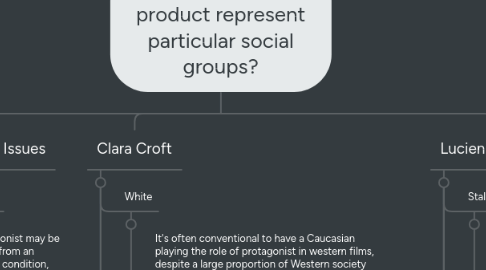
1. Lucien Windsor
1.1. Stalker
1.1.1. From the get go, he's seen as a bad guy, even without any back story and so the audience probably isn't conflicted as to whether or not he is a bad person
1.2. Teenager
1.2.1. He fits a more stereotypical representation of how teenagers are presented in media as he is seen as a danger, yet he is seen as more menacing and vengeful than most who are usually more antisocial than people with a negative agenda against an individual.
1.3. Black
1.3.1. Black people, like those of all races, are presented differently in different contexts - in this case, he is shown to be dangerous, but it is not essential to the plot - we could have had anyone of any race play the role, but we chose based upon who could play an ominous character; him being black isn't essential for the plot.
1.4. Possible Mental Disorder
1.4.1. Obviously, no completely sane person would go out of their way to evoke terror upon another person, so there must be deeper psychological issues making him behave in the way he does, which could be revealed through flashbacks or anecdotes later on in the film
1.5. Male
1.5.1. Male characters are stereotypically show an stronger than female characters and are able to easily assert dominance over them, making it common for them to play the role of the antagonist over a female character. Being physically larger and stronger also puts Clara at a disadvantage if confronted with him, making her an easier target.
2. Clara Croft
2.1. White
2.1.1. It's often conventional to have a Caucasian playing the role of protagonist in western films, despite a large proportion of Western society now consisting of people from all backgrounds. Despite this, she isn't seen as any better or stronger than those of other races as she is still the one being victimised
2.2. Female
2.2.1. Despite being female, the character of Clara isn't stereotypically girly as we can see from her attire and lack of attention towards appearance. This is done to make her character unique, as well as possilbley being relatable to a new generation of teenage girls who prefer staying at home with their computers than going out
2.3. Victim
2.3.1. It's possible to link her gender to her being the victim, which is stereotypical of Hollywood films; a female plays the role of the 'damsel in distress'.
2.3.1.1. A character archetype which can e found in film is the 'damsel in distress' who has to be saved or rescued from a threat because they are weak and cannot defend themselves
2.4. Teenager
2.4.1. Even among teenagers, there are many different representations - more often than not however, they can be presented as being troublemakers or problematic. We tried to present Clara as atypical as she spends most of her time on the internet and interacts with strangers on there more than anyone she knows in real life, almost living as a recluse in terms of real life socialising.
3. Relevant Social Issues
3.1. Mental Disorder
3.1.1. The antagonist may be suffering from an obsessive condition, leading him to become latched onto the idea of Clara
3.2. Gender
3.2.1. Different presentation of male and female characters
3.3. Race
3.3.1. The 2 main characters were of completely different racial backgrounds
3.4. Age
3.4.1. Both of the lead characters are 17 years old and so the films deals with the representation of youth.
3.5. Crime
3.5.1. Though not being a clean cut crime, stalking is a criminal offence and so we are dealing with issues that some viewers may be sensitive to or have previosly experienced

